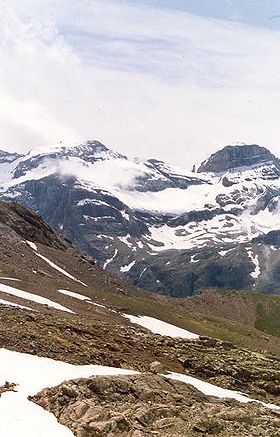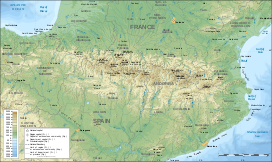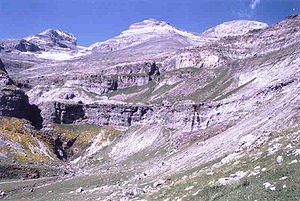- Monte Perdido
-
Monte Perdido 
Monte Perdido (left) and Cilindro de Marboré (right)Elevation 3,355 m (11,007 ft) Translation Lost mountain (Spanish) Location Ordesa Valley, Huesca province,  Aragon
AragonRange Pyrenees Coordinates 42°40′N 0°02′E / 42.667°N 0.033°ECoordinates: 42°40′N 0°02′E / 42.667°N 0.033°E Pyrénées - Mont Perdu * UNESCO World Heritage SiteCountry Spain Type Mixed Criteria iii, iv, v, vii, viii Reference 773 Region ** Europe and North America Inscription history Inscription 1997 (21st Session) Extensions 1999 * Name as inscribed on World Heritage List
** Region as classified by UNESCOMonte Perdido (Mont Perdu in French, both meaning lost mountain) is the third highest mountain in the Pyrenees. The summit of Monte Perdido (3355 m), located in Spain, lies hidden from France by the seemingly impenetrable peaks of the Cirques of Gavarnie and Estaubé. It is in the north of Huesca province. The mountain forms part of the Ordesa y Monte Perdido National Park, in the west of the Pyrenees, in the community of Aragon, Spain.
Access to the mountain is easier from Spain than from France. The route starts near the village of Torla, Aragon, at the Ordesa Valley and ascends the Cirque de Soaso towards the Refuge of Góriz before the stiff climb to the summit. It is a dangerous climb with snow.
National Park
Monte Perdido is the centre-piece of the Spanish Ordesa y Monte Perdido National Park which was established in 1918 with just 21 square kilometres of land. The park has grown significantly to 156 square kilometres and incorporates the whole of the Añisclo Canyon. There are more than 1500 species of flowers, 171 species of birds, 32 different mammals and 8 types of reptile in the Ordesa. Most magnificent of all is the Lammergeier (Bearded Vulture) with a 3 metre wingspan. The Pyrenees is one of the few places in Europe where these birds can be seen.
See also
External links
World Heritage Sites in Spain For official site names, see each article or the List of World Heritage Sites in Spain. North West Caves of Altamira and Paleolithic Cave Art of Northern Spain1 · Monuments of Oviedo and the Kingdom of the Asturias · Roman Walls of Lugo · Route of Santiago de Compostela1 · Santiago de Compostela · Tower of Hercules
North East Caves of Altamira and Paleolithic Cave Art of Northern Spain1 · Mudéjar Architecture of Aragon · Pyrénées - Mont Perdu2 · Rock-Art of the Mediterranean Basin on the Iberian Peninsula1 · Route of Santiago de Compostela1 · San Millán Yuso and Suso Monasteries · Vizcaya Bridge
Community of Madrid Aranjuez Cultural Landscape · El Escorial · University and Historic Precinct of Alcalá de Henares
Centre Archaeological Ensemble of Mérida · Archaeological Site of Atapuerca · Ávila with its Extra-mural Churches · Burgos Cathedral · Cáceres · Cuenca · Las Médulas · Rock-Art of the Mediterranean Basin on the Iberian Peninsula1 · Route of Santiago de Compostela1 · Salamanca · Santa María de Guadalupe · Segovia and its Aqueduct · Toledo · Prehistoric Rock-Art Sites in the Côa Valley and Siega Verde
East Archaeological Ensemble of Tarraco, Tarragona · Catalan Romanesque Churches of the Vall de Boí · Ibiza (Biodiversity and Culture) · Palau de la Música Catalana and Hospital de Sant Pau, Barcelona · Palmeral of Elche · Poblet Monastery · Rock-Art of the Mediterranean Basin on the Iberian Peninsula1 · Silk Exchange in Valencia · Works of Antoni Gaudí
South Alhambra, Generalife and Albayzín, Granada · Cathedral, Alcázar and Archivo de Indias, Seville · Córdoba · Doñana · Renaissance Monuments of Úbeda and Baeza · Rock-Art of the Mediterranean Basin on the Iberian Peninsula1
Canary Islands 1 Shared with other region/s · 2 Shared with France Categories:- Mountains of Aragon
- Mountains of the Pyrenees
- Pyrenean Three-thousanders
- World Heritage Sites in France
- World Heritage Sites in Spain
- Aragon geography stubs
Wikimedia Foundation. 2010.


